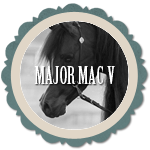"I’ve always known one thing about this breeding business," says Sheila Varian. "That the best way to travel down the road is to take a path right square in the middle and avoid the twists and turns as best you can." Sheila speaks from the wisdom of her near half-century of breeding and ownership of Arabians - years in which she's skillfully negotiated that road, avoiding the ruts and bumps.
Through the application of that approach, Sheila has gained renown as the consistent breeder of the "beautiful athlete," an Arabian that can do most anything and also stand up and look beautiful. Along with that distinction, she's bred scores of National Champions and has bred four of the five sires in the Varian five-generation chain of stallions.
Sheila got her first horse when she was eight, her first saddle when she was twelve. Judy, a Morgan-Percheron cross, and Sheila rode hundreds of happy miles together near their home on California's central coast.
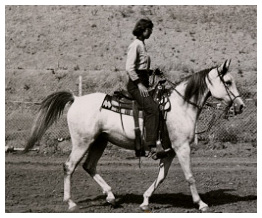 Then in 1952 came the two year old Farlotta (*Lotnik x Farza by Sahar), Sheila's first Arabian. Frightened, belligerent, thin, and wormy didn’t matter to Sheila except that the mare was hers. "I ate my dinner in her manger, I dreamed in the sun lying stretched out on her back, earned her trust, finished her in a spade bit, won western and stock horse championships with her, considered her my best friend, and held her in my arms when she died at age seven from the worm damage she sustained as a youngster."
Then in 1952 came the two year old Farlotta (*Lotnik x Farza by Sahar), Sheila's first Arabian. Frightened, belligerent, thin, and wormy didn’t matter to Sheila except that the mare was hers. "I ate my dinner in her manger, I dreamed in the sun lying stretched out on her back, earned her trust, finished her in a spade bit, won western and stock horse championships with her, considered her my best friend, and held her in my arms when she died at age seven from the worm damage she sustained as a youngster."
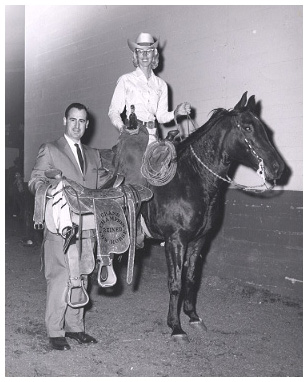 Ronteza (*Witez II x Ronna by Faronek) gave Sheila a new window on the world. At the Cow Palace in San Francisco, the two notched three firsts: the first Arabian, the first female rider, and the first amateur rider to "win the world" - the Open Stock Horse Stakes against all breeds.
Ronteza (*Witez II x Ronna by Faronek) gave Sheila a new window on the world. At the Cow Palace in San Francisco, the two notched three firsts: the first Arabian, the first female rider, and the first amateur rider to "win the world" - the Open Stock Horse Stakes against all breeds.
In 1959, the now-legendary Sheila and Bay-Abi (Errabi x Angyl by *Raseyn) encounter occurred at an Arabian horse sale at the Cow Palace. "We were familiar with Angyl, Bay-Abi’s dam. I knew from the moment I saw him that this was what I was looking for in the way of a breeding stallion," Sheila recalls. "Wonderful face and ears. Three equal circles for his shoulders, barrel, and hips. A long tail dock, his tail carried straight and high. Excellent feet. An inquisitive expression that I see everywhere today.
"Because our first two mares Farlotta and Ronteza were sired by Polish stallions, we became interested in the Polish bloodlines and found them in Bay-Abi. Early on, we recognized that Skowronek was Polish. Bay-Abi's maternal grandsire *Raseyn was a Skowronek son and his maternal grandam *Wierna was foaled in Poland.
The Varians knew what they wanted to produce. Getting there was another question. To this end, Wenonah Varian wrote to Patricia Lindsay of Stockings Farm in England, who, working with Gladys Brown Edwards in California, had created what they called the Threadbare Import Company, a mail-order service, in effect, for importing horses from Poland.In 1961 Mrs. Varian wrote:
"Dear Miss Lindsay: We have a small farm in Arroyo Grande, California, and understand you travel to Poland and are familiar with the country and the horses there. My daughter's interests are in breeding, training, and showing. We desire to breed beautiful athletes. Looking forward to heating from you."
"I enjoyed your letter," came the reply from Miss Lindsay. "Your program sounds very interesting. Yes, I do speak Polish and am familiar with the country and the horses. I'll be traveling to Poland this spring, and although I haven't purchased horses for other people often, I'd be glad to help you if I can. Looking forward to meeting you one day."
In Poland, Miss Lindsay first found *Ostroga (Duch x Orda by Omar 11), a 1956 bay mare, at Michalow Stud. Delicate and refined, with a wonderful trot. Miss Lindsay relates the delightful account of her discovery of the grand mare *Naganka (Bad Afas x Najada by Fetysz), a 1952 grey in foal to *El Mudir, bred by Nowy Dwor Stud:
"I paid a visit to Mr. Joszef Tyszkowski, the director of Nowy Dwor Stud, which was being disbanded. I found a few excellent horses left for sale. Near a small stable at the stud, I studied an elderly mare with foal at foot, when suddenly a big grey mare, holding herself like an aristocrat, jumped out of her stall and out over the end door of the barn (a good four-foot-high door) and came charging after the mare and foal, tail held high, at a spanking trot, as if determined to catch my eye. 'Take me. Take me,' she seemed to say. I immediately thought of the Varians and their performance horses, so I wrote to Wenonah: 'This mare *Naganka is a flamenco dancer. I think you should have her.' Earlier, I'd found the gorgeous *Bachantka (Wielki Szlem x Balalajka by Amurath Sahib), a 1957 grey foaled at Albigowa Stud. This one I desperately wanted for myself. She had not been for sale previously, but by then I had too many horses, so I was thrilled to acquire her for the Varians, where I knew she would be appreciated." And so the Varians purchased three mares, not just one as they had originally planned.
"The level of anticipation and excitement for the family was off the scale," Sheila remembers. "As the mares were en route, I dreamed about them almost every night. I dreamed they had ears like donkeys, that they didn't even live up to the quality of the snapshots from which we made our choices. Then at 7:00 a.m. on December 9, 1961, the three stepped onto the Varian ranch. By that time they'd had six weeks of constant moving and changes of feed - four weeks on a boat and two weeks on a van from New York. A bedraggled lot, tired little souls. Not only were they physically in disrepair, but emotionally and mentally as well. But thin and tired as they were, they were beautiful, and we were ecstatic. All the doubts and concerns were erased. They were the Arabians we had been looking for."
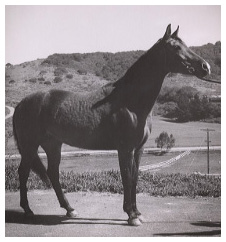 *Ostroga |
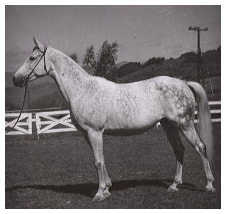 *Naganka |
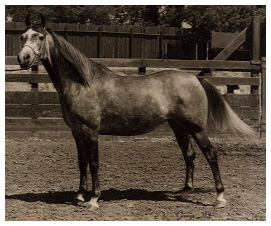 *Bachantka |
The following year, Sheila recalls, she got a "lot of guff" from other breeders when she bred the three mares to Bay-Abi, rather than breeding them to a straight Polish stallion. "Every third year, I bred the Polish mares to Polish stallions for seed stock; however the resulting foals from the cross to Bay-Abi were far superior so I abandoned that practice and totally concentrated on the cross of Bay-Abi on the Polish mares. Much to the consternation of the American pure Polish faction. The only exception being Balalinka (*Bask x *Bachantka), whom I kept as a broodmare.
Sheila spent much time in the spring and early summer of 1962 convincing Bay-Abi he was the most beautiful horse on earth. He'd already been awarded Champion stallion at a Cow Palace show, and the U.S. Nationals classes (stallions and mares only) at Estes Park, Colorado, beckoned. "At Estes Park, we were not considered contenders by the other owners. No one knew of Varian Arabians at Arroyo Grande, California, or of Bay-Abi. I knew ahead of time how the class would be presented: 3 judges, no preliminary cuts and 45 stallions all together in the ring for the National Championship ... for four and one-half hours. By the end of the class most of the horses were exhausted and nearly asleep. Not Bay-Abi. He huffed and puffed and snorted, or went to sleep, on voice command. Looked great the whole time. The judges thought so too. He was the unanimous 1962 U.S. National Champion Stallion."
In spite of the Varians' geographic isolation and limited showing, the word of the Polish mares did get to the Arabian horse community. Late in 1962, Minnesota breeder Daniel C. Gainey wrote, in part, to fellow breeder Burr Betts: "That grey mare (*Bachantka) Sheila Varian had at Estes is about as good as I have ever seen, in spite of her big ears and rather long head. She has another Polish mare at her place, which is supposed to be equally good. The reports are that Miss Varian would not think of selling either of these mares. Is there a chance that she will have equally good foals from them that one might buy? You could find out about this better than I because you know her personally. Also - and this is quite important - would she mind letting you know where she bought these mares? Are there others available at the same source or elsewhere in Poland?" Sheila was flattered but declined any offers.
In 1969, Sheila got acquainted with a bright new bay colt in Southern California and leased him for his first breeding season. Khemosabi (Amerigo x Jurneeka by Fadjur) sired three daughters for Sheila - Khema (x *Ostroga), Moska (x Baychatka, *Bachantka's daughter by Bay-Abi), and Bay-Sabha (x Bay-Cinda by Bay-Abi). Plus the stallion Kaiyoum (x Bayanka, a full sister to Baychatka). "Just a good horse, always has been a good horse," says Sheila of Khemosabi. "His daughters are wonderful producers."
A 1973 mare shopping venture took Sheila to Sweden, where she purchased six mares and the stallions *Essaul (Comet x Ela by Miecznik) and *Enos (Witraz x *Enorme by Trypolis), all pure Polish in pedigree. She wrote her own export papers, with the help of an American seasoned in such matters; loaded them on a transport plane, flew to London with them, where she adamantly forbade airline personnel to add an elephant to the livestock on board; dealt with routine import technicalities in New York and a mare's colic over the Rookies; and delivered them all safely to their new home in Arroyo Grande, California. All became useful breeding stock.
The Varian breeding plan was set. "I didn't breed my stallions to follow any trends," Sheila reported in 1982 although that was difficult at the time. "I've always tried to take the best stallion and breed it to the best mare for the purposes I had in mind. I have had a deep fondness for the Arabians from Poland - however I recognize that all Arabians came from the desert originally so quality is more important than origin." The cross of Bay-Abi on the Polish mares never failed. Bay-Abi never failed, in fact; every Bay-Abi offspring Sheila took to the National level went Top Ten or better. Ronteza, who must also be considered a foundation mare, was bred to Bay-Abi nine times, producing three National Champions by him.
"We’ve learned over the years that *Naganka's strength was obviously through the male line, *Bachantka's through the female line, and *Ostroga's through her ability to produce trot," Sheila recounts. "We are now in the eighth generation from *Bachantka in tail female and every one a great mare. These strengths make for strong pedigrees and they lend dependability to the breeding decisions. We now have a built-in predictability.
Bay El Bey, *Naganka's 1969 colt by Bay-Abi, gave the Varian program a sizable boost in predictability. Bay El Bey, a colt with a destiny to be a National Champion Stallion, shone in the show arena, but his forte was as a breeding stallion. Long a leading sire in the major U.S. shows and sire of a dynasty of males that consistently bring in similar honors, he is particularly well known for his sons and is referred to as "the King Maker" in America.
In 1976, Bay El Bay's son Huckleberry Bey (x Taffona by Raffon) was foaled - a future Varian sire that, in Sheila's thinking, clinched the predictability factor for Varian Arabians. Huckleberry Bey in turn sired Desperado V (x Daraska by *Dar), who in his ten years of siring has intensified the predictability of the program.
Desperado V has been a leading sire in the American Stud Book since he began breeding as a 2 year old in 1988. He has been the number one leading sire for the past four years. Desperado V’s popularity has extended world-wide with frozen semen in Brazil, Venezuela, South Africa and in 1995, a Desperado V frozen semen station was established with Bob Bates of Weirton Stud in Gloucester, England. This station has served the U.K., the countries of Western Europe, Scandinavia, and the Middle East. All Desperado V semen at the U.K. station is W.A.H.O. approved and the young foals of Desperado V have begun to represent the Varian Arabian breeding program successfully both in the show ring and in the hearts of many breeders.
With Desperado V's success as a sire, Sheila celebrated four generations of Varian stallions sires respected for their consistency, for their ability to preserve and enhance the excellence of their sire line while, at the same time, adding their own particular traits of motion, conformation, and personality. Four Arabian Horse World Sires of Significance, four sires of National Champions and Reserves in both halter and performance. Four easy-to-live-with stallions who gratified Sheila's sense of the "good horse," no matter how or where used.
Within the Varian program, Sheila has found temperament the most heritable feature. "A high priority for me. I've weeded out horses for lack of good temperament. To me, a good disposition does not just mean that a horse is nice to pet. Good disposition means that a horse trains well, that it retains what it has learned from one day to the next, that it accepts training with an open mind, that it doesn't require punishment and doesn't require excessive work. Of course, we start with excellent conformation and then just make our horses prettier and prettier.
"Yes, I have been close to breeding my ideal Arabian. No, I haven't bred a perfect Arabian - that's the pleasure - the continuation, the evolvement, the next generation," says Sheila.
"I see the program as ever-evolving, so I'm always bringing in outside blood, either by buying a mare every now and then, or breeding my mares out. Or both. If I see a mare that really appeals to me, I'll purchase her."
"The old mares? They're here. I'm pretty much of a softy on keeping them. Can't look into those faces and think they might be having I a tough time of it somewhere else. So I have six to eight mares of age 25 and over. Some are still producing. Plus I happen to love the old horses. They have the wisdom of old people; they know their lives and have life figured out."
How to tell a Varian horse? "Varian Arabians look beautiful and useful. That's the first clue," says Sheila. "A person who has an eye for form (in the architectural sense) will like these horses because they're well balanced throughout. And they're pretty. With a little different look to their heads and faces, a softness of the eye, a look that suggests they're agreeable with the world. They're not anxiety-filled horses and that's why they're so tremendously popular with people. They're hands-on horses - breeding or showing or pleasure."
For Sheila, the thrills come not just in show championships, but in every aspect of knowing Arabian horses. "I love to show and I show my own horses," Sheila says, "but I don't need to go through the stress of the Nationals to make myself happy. I don't require the confirmation of ribbons to know that I'm doing well. I'll never lose my interest in training and I think I'm a better trainer now than I've ever been.
Sheila has her own priorities for the Varian ranch and the breed: "In terms of what's good for the breed, I don't rank financial return first. I believe that if you do a good job and are willing to sacrifice for what you know is right and educate yourself on all aspects of your endeavors, listen to others (but make up your own mind and not be swayed by political pressures), when you live to be 100, success is probably assured. I'll stand up and fight for something that's good for the Arabian horse, through every organization and political entity available within the industry."
From the I-want-a-horse years of her childhood through to the late 1990s, Sheila's determination, talent, and direction have taken her to her goal: that of consistently producing for the breed the beautiful athletes, the show winners, the companion horses, the family horses, and the excellent reproducers. The Arabian horse community has come a long way from 1952, when Sheila first owned an Arabian; she has ridden out the twists and turns, and the breed and the community are the beneficiaries of her diligence, wisdom, and perseverance. The numbers of winners by Varian stallions or out of Varian mares is in the hundreds each year. No other farm is having the consistent success of the Varian program.
Reflecting on the achievements of her world renowned breeding program, Sheila Varian comments: "Many years and many great horses have come and gone since Patricia Lindsay selected our first foundation mares from Poland. We are proud to now offer the results of those many years here in England, Ms. Lindsay’s homeland. I hope she is as proud as we."



